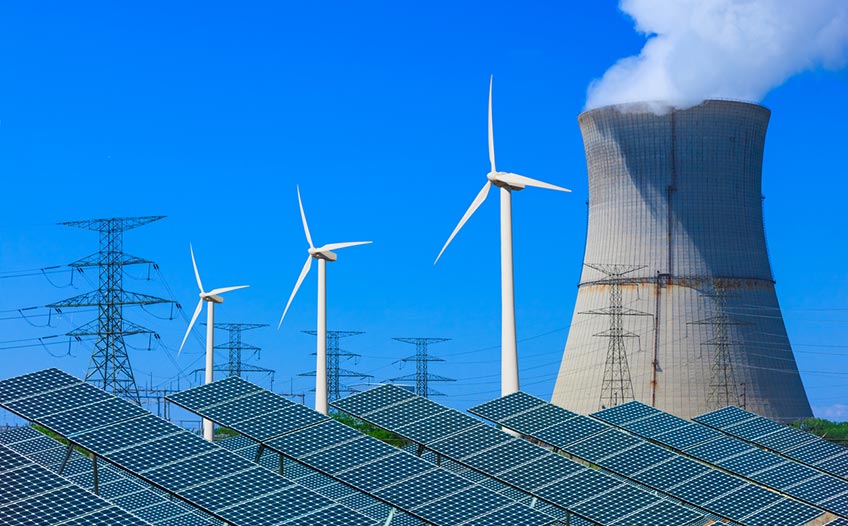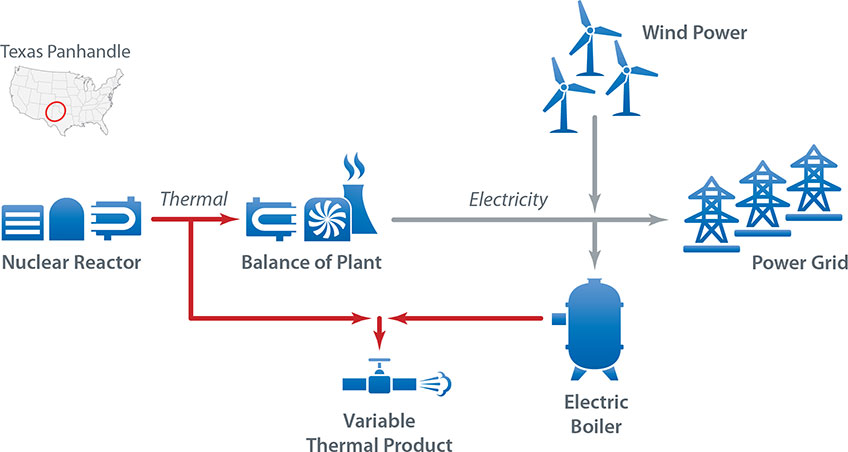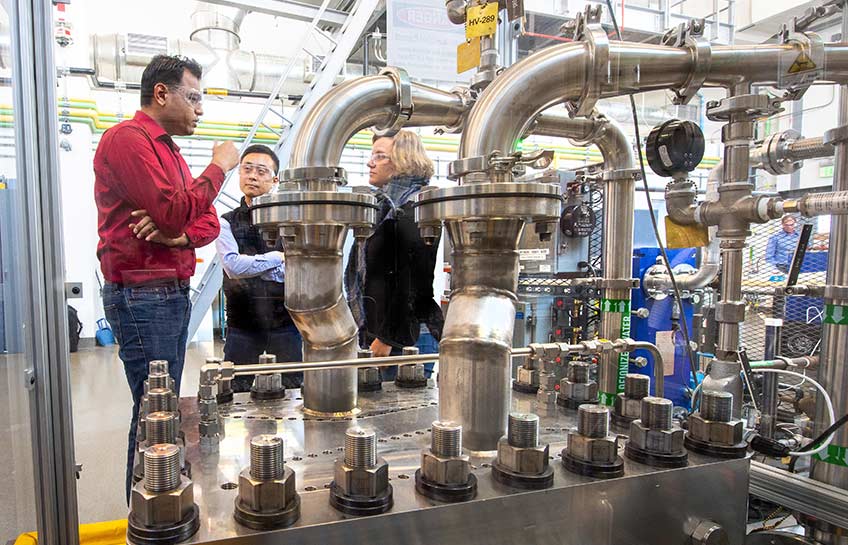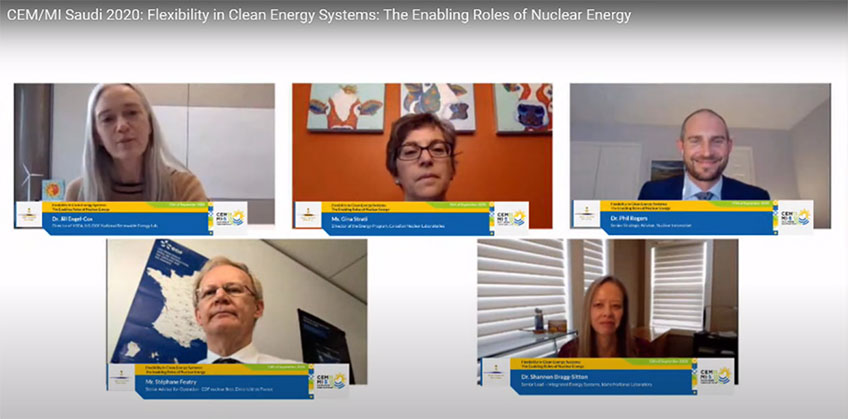Nuclear-Renewable Synergies for Clean Energy Solutions

This story was originally published on JISEA.org.
The definition of clean energy does not always include nuclear energy, but it is one of the world's largest sources of low-carbon electricity, second only to hydropower. When considering greenhouse gas emissions, nuclear has the potential to be a key part of clean energy solutions.
Since 2011, the Joint Institute for Strategic Energy Analysis (JISEA) has explored the potential for increased integration of nuclear and renewables in the evolving power grid. "When we think outside of the box with nuclear energy, there are many valuable roles that it can play in harmony with renewables to add resilience and flexibility to the power grid," said Jordan Cox, a JISEA/National Renewable Energy Laboratory (NREL) analyst who focuses on nuclear research.
Nuclear-renewable hybrid energy systems are physically coupled facilities that include both nuclear and renewable energy sources to produce electricity and another commodity product such as fuel, thermal energy, hydrogen, or desalinated water. They can provide electricity when the grid needs it and produce the commodity during other hours, increasing the economic benefit of the nuclear reactor.
Starting in 2011, JISEA partnered with NREL and Idaho National Laboratory to host a series of workshops with industry, academia, policymakers, and international organizations to discuss the potential of these systems. As a result of these workshops, JISEA led a study on nuclear-renewable hybrid energy systems, which culminated in a series of reports.
One report identified key sources of greenhouse gas emissions in 14 of the most energy-intensive industries, which represented 25% of industrial sector atmospheric emissions in 2014. The analysts determined that nuclear-renewable systems could technically meet the thermal and electrical energy needs of biofuel production, wastewater purification, desalination, hydrogen generation, food processing, synthetic gasoline production, chemical manufacturing, and pumped hydro and compressed-air storage.
In another report, analysts introduced two hypothetical nuclear-renewable hybrid energy systems to evaluate economic potential under certain market conditions. The systems were profitable with high electricity prices and only when the variable renewable energy generated some of the electricity needed to receive capacity payments, while minimally reducing the cost of the industrial product.
The final report in the series investigated the economic potential of nuclear-renewable hybrid energy systems to generate electricity and produce thermal energy for industry. The systems were profitable in modeling scenarios with higher costs of natural gas generation and a carbon pricing market.

Under a variety of scenarios, the economically optimal system configuration included a nuclear reactor to exclusively generate a thermal product. In all scenarios, this configuration had a higher rate of return than a natural gas boiler. In one scenario with only a nuclear reactor, the $1.8-million system investment had a $94.4-million net present value over the first 25 years of its operational life. The nuclear reactor could also prevent 281,000 metric tons of CO2 annually compared to a natural gas boiler.
These systems also showed potential to support resource adequacy on the grid with sufficient market incentives. In addition, at high thermal product prices and low electricity prices, these same systems could open up new markets for wind generation and increase profitability because wind-generated electricity could be converted to heat.
Collectively, the reports showed that, when linked together, nuclear and renewable energy generation could produce low-carbon electricity, provide high-value products for industry, and improve grid operations. "These reports were foundational in our understanding of how nuclear generation could participate in the grid of the future," said Mark Ruth, a JISEA/NREL analyst and co-author.
Potential for Hydrogen Production
In 2017, building upon the early reports, JISEA studied the economic potential of tightly coupled nuclear-renewable hybrid energy systems that produce hydrogen and generate electricity. The systems were profitable in scenarios with higher electricity and natural gas prices, low hydrogen prices, and increased electricity price volatility.
The optimal technology configuration in these scenarios included a nuclear reactor, thermal power cycle, and wind power plant. Other economic drivers like a societal cap on natural gas use, a clean hydrogen standard, or a limitation on the use of natural gas production technologies increased profitability.
These findings were summarized in a paper for the International Atomic Energy Agency. The analysis provided foundational informational for the H2@Scale initiative, a high-priority collaboration under the Hydrogen and Fuel Cell Technologies Office in the U.S. Department of Energy's Office of Energy Efficiency and Renewable Energy.
H2@Scale explores potential widescale hydrogen production and utilization in the United States to support the electric grid and play a larger role across industry and transportation. In 2018, Mark Ruth and Jill Engel-Cox presented the H2@Scale concept at the 6th International Conference on Nuclear and Renewable Energy Resources in South Korea.

According to the latest study in the H2@Scale initiative, the U.S. demand for hydrogen could increase up to fourfold with current and emerging sectors, given advances in research and development and varying prices of natural gas and electricity. Hydrogen could feasibly serve as a responsive load on the electric grid, enhance grid stability, reduce curtailment, and create an additional revenue stream for electricity generators. This functionality can support increasing renewable penetration.
Elevating Nuclear Research with NICE Future Initiative
In 2018, JISEA invigorated its commitment to nuclear-renewable research with the announcement that it would serve as operating agent of the Clean Energy Ministerial's Nuclear Innovation: Clean Energy (NICE) Future initiative, which convenes global expertise to analyze nuclear energy as a clean, reliable energy source in both electric and nonelectric sectors.
As the operating agent of Clean Energy Ministerial's 21st Century Power Partnership, JISEA had been recognized for its objective international analysis and was a natural home for the NICE Future initiative to continue research on nuclear energy in clean energy systems.

In 2019, NICE Future presented webinars on diverse topics ranging from technical opportunities like the promise of small modular nuclear reactors to social issues like gender mainstreaming in the global nuclear sector. Under JISEA's stewardship, the U.S. NICE Future team received a 2018 Secretary of Energy Achievement Award—the U.S. Department of Energy's highest honor for teams who have gone above and beyond in fulfilling its mission and serving the nation.
How Flexible is Nuclear Energy?
As more low-cost variable renewable energy is added to the grid—projected to supply half of the world's electricity by 2050—nuclear energy is recognized as a potential option to produce heat and electricity as needed, while also reducing atmospheric emissions. But the question now is, how flexible is nuclear?
Nuclear flexibility was examined in a new international report led by the NICE Future initiative with insight from 20+ organizations worldwide. Led by Jordan Cox, the Flexible Nuclear Energy for Clean Energy Systems report demonstrates that nuclear energy does provide power system flexibility and its full potential can be realized through tightly coupled nuclear-renewable energy systems that could ultimately help lower atmospheric emissions.
One chapter of the report led by JISEA/NREL analysts evaluated flexible, low-cost nuclear energy with increased renewable energy penetration to the U.S. power system across possible future scenarios through the year 2050 with both high variable renewable energy and highly flexible nuclear energy.
Across all scenarios, the introduction of low-cost, flexible nuclear energy (more than just low-cost traditional nuclear) reduced system costs and increased renewable capacity. In one low-emissions scenario, the availability of low-cost nuclear energy decreased electricity costs by $23.2 billion and increased nuclear capacity by 40 GW. Further innovation can increase the flexibility of existing nuclear reactors.
Continuing To Think Outside the Box
Although analysis on the role of nuclear and renewables in the evolving power system has advanced, JISEA work remains. New technologies like advanced inverters are paving the way for innovative nuclear solutions to industrial decarbonization, grid integration, and solving other challenges related to the clean energy transition.
As part of a collaboration among the U.S. Department of Energy's three applied energy laboratories—Idaho National Laboratory, the National Energy Technology Laboratory, and the National Renewable Energy Laboratory—JISEA supported a recent study on novel multi-input, multi-output hybrid energy systems that synergistically incorporate diverse energy sources, including renewable, nuclear, and fossil with carbon capture, to provide sustainable, cost-effective, and reliable power, heat, mobility, and other energy services.
Outlined in a new Joule article, the scientists identified a viable path forward for these energy systems—a major step toward understanding today's most complex energy challenges.
"Further research is an important next step to continue understanding how nuclear and renewables can play complementary roles," said JISEA Director and co-author Jill Engel-Cox. "Together, they can help keep balance on the grid and address one the biggest global issues of today: reducing atmospheric emissions."
Note: The Joint Institute for Strategic Energy Analysis retired in February 2025.
Last Updated May 28, 2025
